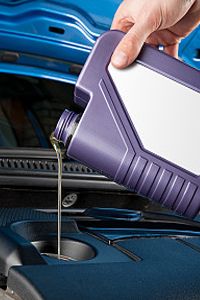Choosing the Right Type of Motor Oil
Often times a manufacturer will suggest two or more motor oil viscosities for an engine, such as a 5W-20 or 5W-30, based on several different factors -- including temperature. The reason for this is that engines often need a different viscosity based on operating conditions. Knowing how scientists see viscosity will help an owner determine the best oil for the engine.
Viscosity, at its most basic, is a fluid's resistance to flow. Within the engine oil world, viscosity is notated with the common "XW-XX." The number preceding the "W" rates the oil's flow at 0 degrees Fahrenheit (-17.8 degrees Celsius). The "W" stands for winter, not weight as many people think. The lower the number here, the less it thickens in the cold. So 5W-30 viscosity engine oil thickens less in the cold than a 10W-30, but more than a 0W-30. An engine in a colder climate, where motor oil tends to thicken because of lower temperatures, would benefit from 0W or 5W viscosity. A car in Death Valley would need a higher number to keep the oil from thinning out too much.
Advertisement
The second number after the "W" indicates the oil's viscosity measured at 212 degrees Fahrenheit (100 degrees Celsius). This number represents the oil's resistance to thinning at high temperatures. For example, 10W-30 oil will thin out at higher temperatures faster than 10W-40 will.
The owner's manual will advise the best viscosity range and the owner can then work within those parameters.
With the right viscosity in mind, it's time to start shopping for a type of oil. Most commuters follow the 3-month and 3,000-mile (4,828-kilometer) rule. Frequent oil changes means there's less tendency to need other types of oil than conventional. However some car companies, like Mercedes-Benz and BMW, recommend only synthetic oil in their cars. The following list, as well as the car's owner's manual, will provide a good idea of what type of oil to use. It's also a good rule of thumb not to switch between types. If your car started with conventional, stick with that. If it first used synthetic, be wary about switching to conventional.
- Conventional Oil: This is the oil used in bulk at dealerships and is the cheapest at the auto store, too. Most adhere to API and SAE standards but offer little in the way of additive packages. This is good oil for owners that are religious about frequent oil changes and have low-mile (but well broken-in) engines.
- Premium Conventional Oil: This is the standard new-car oil. Most leading brands have one for SL, or highest level, service. Most are available in the common viscosities. Car manufacturers usually specify 5W-20 or 5W-30 oil, though some require 10W-30. These three ratings cover just about every light-duty vehicle on the road, though this is changing as engines become more precise and fussy about specific types oil.
- Full-synthetic Oil: These oils are made for high-tech engines. If these oils pass stringent special tests (indicated by their labeling), it means they have superior, longer-lasting performance in all the critical areas, from viscosity index to protection against engine deposits. They flow better at low temperatures and maintain peak lubrication at high temperatures. While excellent oil, synthetics are about three times as expensive as conventional oil and not always necessary for most engines. Use the owner's manual as a guide. If it doesn't call for synthetic oil, using it will only be an additional expense that may not add anything to the engine's performance or life.
- Synthetic-blend Oil: This is essentially premium conventional oil hit with a dose of synthetic. They're formulated to offer better protection during heavier engine loads and the associated higher engine temperatures. These oils are popular with pick-up and SUV drivers because they do offer better protection, but usually cost only a fraction more than premium conventional oils.
- High-mileage Oil: More than 60 percent of vehicles on the road have more than 75,000 miles (120,701 kilometers) on the odometer. Playing to this growing market, oil refiners and labs developed high-mileage oils. Seal conditioners are added to the oil (the oil can be synthetic or conventional) to expand and increase the flexibility of internal engine seals. The conditioners are very precise and can benefit some engines while not affecting others.
Some companies also add viscosity modifiers to thicken the oil, as well as anti-wear additives. We'll discuss those on the next page.
